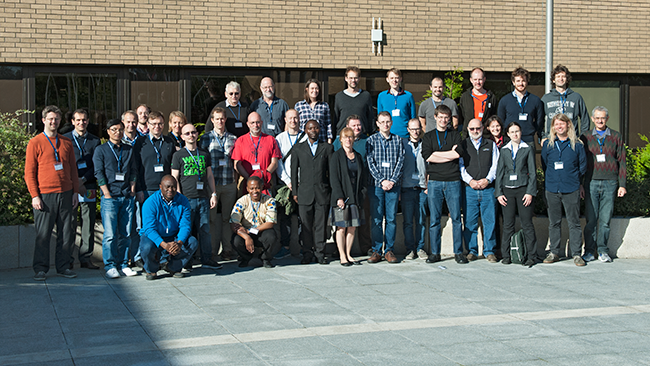ECMWF | Reading | 3-6 October 2016



Workshop description
The workshop aimed to bring together scientists working on the various aspects of model development. In particular, interdisciplinary research and progress on numerical schemes, parallel and energy-efficient computing, coupling of resolved/subgrid-scale parametrised processes and multiscale interactions that could be relevant for numerical weather prediction were welcomed.
The workshop continued a successful series of scientific and technical exchange using forward-in-time differencing for fluids with the EULAG model, bringing together different disciplines of geophysical modelling research, with previous workshops in Bad Tölz, Sopot, Loughborough, and Mainz.
Presentations
Monday 3 October
| Welcome Erland Källén (ECMWF) |
|
| Results and challenges with Dynamo, the Met Office’s next generation dynamical core Tommaso Benacchio (Met Office) |
|
| A finite-volume module for cloud-resolving simulations of global atmospheric flows Piotr Smolarkiewicz (ECMWF) |
|
| Dimension splitting errors and a long time-step multi-dimensional scheme for atmospheric transport Hilary Weller (University of Reading) |
|
| Towards Exascale Computing with the Atmospheric Model NUMA Andreas Müller (ECMWF) |
|
|
Split-explicit methods and local linear splitting Oswald Knoth (Leibniz Institute for Tropospheric Research) |
|
| Computation at a coordinate singularity Joseph Prusa (Teraflux Corporation) |
|
| Challenges in weather and climate modelling on the route to exascale Gianmarco Mengaldo (ECMWF) |
|
| Improving accuracy over steep slopes James Shaw (University of Reading) |
|
| A finite-volume module for the IFS Christian Kühnlein (ECMWF) |
Tuesday 4 October
|
Moving meshes over orography without conservative re-mappings |
|
| An unstructured mesh NFT approach to all-scale atmospheric flows Mike Gillard (Loughborough University) |
|
| Spectral deferred corrections with fast-wave slow-wave splitting Daniel Ruprecht (University of Leeds) |
|
| Applying the Laplace transform integration scheme in OpenIFS Eoghan Harney (University College Dublin) |
|
| Third-order accurate MPDATA for arbitrary flows Maciej Waruszewski (University of Warsaw) |
|
| Sensitivity of the ECMWF model to semi-Lagrangian departure point iterations Michail Diamantakis (ECMWF) |
|
| The use of inexact hardware to improve weather and climate predictions Peter Düben (University of Oxford) |
|
| Application of anelastic and compressible EULAG solvers for limited-area numerical weather prediction in the COSMO consortium Damian Wójcik (IMGW-PIB) |
|
| Modeling of daytime convective development over land with COSMO-EULAG Bogdan Rosa (IMGW-PIB) |
|
| Can we model unresolved effective mass transport in a NWP model? Sylvie Malardel (ECMWF) |
Wednesday 5 October
| Simulating the characteristics of tropical cyclones over the South West Indian Ocean using a stretched-grid global climate model Babatunde Abiodun (University of Cape Town) and Molulaqhooa Maoyi (University of Cape Town) |
|
| Separating dynamical and microphysical impacts of aerosols on deep convection applying piggybacking methodology Wojciech Grabowski (NCAR) |
|
| Idealized model simulations of gravity wave propagation – modi fications in the tropopause region Vera Bense (Johannes Gutenberg University) |
|
| Turbulent transport of the energy in the entrainment interface layer Marta Kopeć (University of Warsaw) |
|
| Global instabilities and mode transitions in magnetohydrodynamical ILES simulations of solar convection Paul Charbonneau (Université de Montréal) |
|
|
Modulated heat transport in global MHD simulations of solar convection |
|
| Behind the scenes: benchmarking sub-grid scales models in global simulations of stellar convective dynamos Antoine Strugarek (Université de Montréal) |
|
| EULAG 2016 – status and challenges Zbigniew Piotrowski (Poznan Supercomputing and Networking Center) |
Thursday 6 October
| The impact of neutral boundary layer turbulence on wind turbine wake: A numerical modelling study Andreas Dörnbrack (DLR) |
|
| Large-eddy simulations of a wind turbine wake above a forest Zbigniew Piotrowski (Poznan Supercomputing and Networking Center) and Andreas Dörnbrack (DLR) |
|
| Numerical simulation of stably stratified atmospheric flow around isolated complex-shaped tall building Michał Korycki (National Centre for Nuclear Research) |
|
| Entrainment and anisotropic turbulence in large-eddy simulation of the stratocumulus-topped boundary layer Jesper Pedersen (University of Warsaw) |
